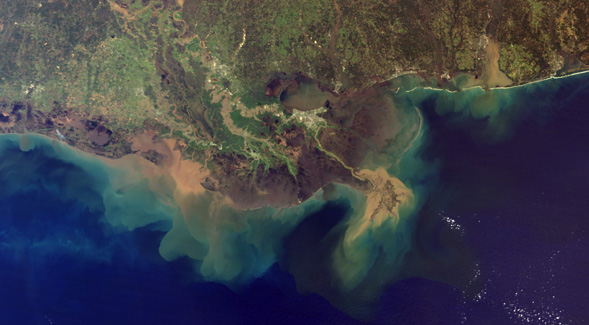Dams and Levees Lead to Slow Underwater Landslides
An SDSU geologist has found the Mississippi River Delta is slowly receding below the waterline.

For thousands of years, the mighty Mississippi River carried sediment downstream as it flowed into the Gulf of Mexico, building out the iconic Mississippi River Delta. As humans have built large dams and levees along the river over the past two centuries, sediment flow has been reduced, resulting in the slow recession of the delta since the 1950s.“We’re definitely seeing a big change to the seafloor ecosystems, but more research will be needed to see what the consequences will be.”
Now, a recent study led by San Diego State University geologist Jillian Maloney has found that this sediment recession is happening below sea level as well, resulting in changes to the seafloor that could threaten seafloor ecosystems and oil pipelines.
“Sediment deliverance historically has been enough to expand the delta, but due to lots of different factors, we’re seeing a decline in sediment flow and a recession in the delta—even underwater,” Maloney said.
Maloney began working on the project in 2013 while she was a postdoctoral researcher at Louisiana State University. She and colleagues knew the delta was losing land above water—about a football field’s worth of sediment every hour—but nobody knew exactly what was happening in the depths. So they sought historical measurements of the underwater geography from underwater maps dating as far back as 1764, as well as a variety of research papers produced by academics and the oil and gas industry. They then compared these historical data to modern sonar soundings and surveys.
The researchers found the underwater portion of the Mississippi River Delta has indeed receded in many places, though it’s difficult to say just how much has been lost over the years, they reported in the journal Marine Geology. The constant sloshing of waves back and forth continuously knocks sediment loose, and floods and hurricanes can also erode sediment below the waterline. As levees and dams have sprung up along the Mississippi River, less sediment flows out to replace this loss, contributing to the recession.
Oil pipelines and platforms sit in the sediment, so the delta’s erosion can damage equipment, Maloney explained. Though her team didn’t look specifically at how the delta’s recession impacts ocean life, she said the seafloor habitat patterns could be shifting in response.
“We’re definitely seeing a big change to the seafloor, but more research will be needed to see what the consequences will be,” Maloney said.
The findings from the study could shed light on what’s happening in other river systems around the world, such as the Sacramento–San Joaquin River Delta.
“Any river systems that have been modified and have less sediment flowing out could also be experiencing this,” she said.


